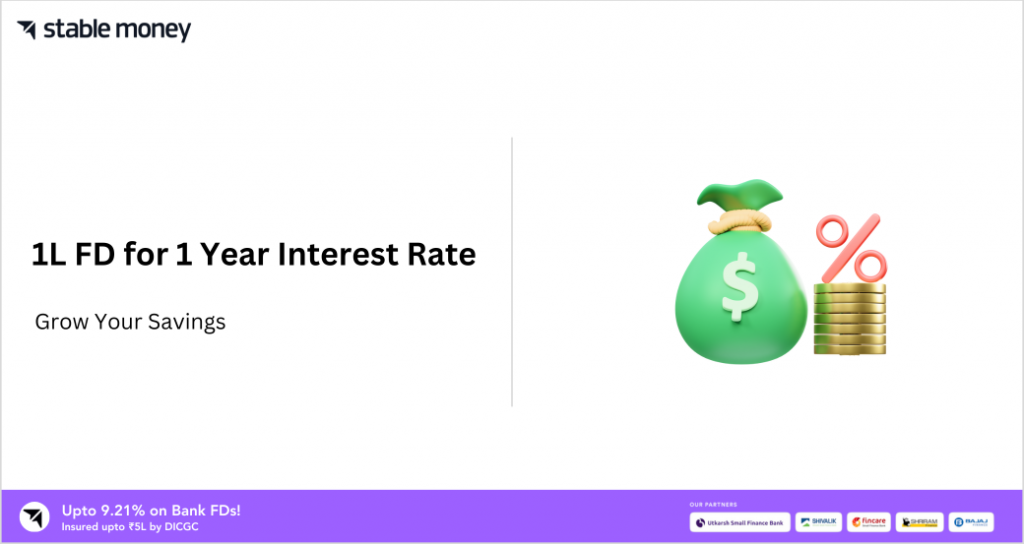
Secure financial assets like Fixed Deposits (FDs) help people increase their money. Investment alternatives abound, but a 1 lakh FD for 1 year is incredibly beneficial. This blog explains the basics of an FD and its potential for financial stability. Then, the interest earned over a year is examined to clarify the financial advantages and the returns of this time-tested financial plan.
1L FD for 1 Year Interest Rate – 2024
Your 1 lakh fd interest for 1 year in HDFC depends on the bank, its duration, and if you’re a senior citizen.
Here is a general range of interest rates for 1L FDs for 1 year in India:
- For regular citizens: 4.50% to 7.50% per annum
- For senior citizens: 5.25% to 8.00% per annum
Here are some examples of interest rates offered by different banks for 1L FDs for 1 year:
- State Bank of India (SBI): 4.75% to 6.50% per annum
- HDFC Bank: 4.50% to 7.00% per annum
- ICICI Bank: 4.50% to 6.90% per annum
- Axis Bank: 5.75% to 7.00% per annum
It would help if you compared rates from several banks and financial institutions to get the best 1L FD interest rate for 1 year. An online FD calculator lets you compare rates and calculate deposit interest.
1L FD for 1 Year in SBI
The 1 lakh fd interest for 1 year SBI is 6.80%–7.30%. This may change depending on whether you pick regular interest payment or compounding.
Here’s a breakdown of the interest rates offered by SBI for 1-year FDs:
- Regular Interest Payout: 6.80% p.a.
- Interest Compounding: 7.30% p.a.
Seniors get 0.50% more on . Senior citizens may earn 1 lakh fd interest for 1 year in post office. 7.30–7.80% p.a. on a 1-year 1L SBI FD.
1L FD for 1 Year Post Office
The post office 1 year fd interest rate is 6.90% annually. Under the existing arrangement from January 1 to March 31, 2024, ordinary and older adults pay this rate.
Here’s a Quick Summary of what You Can Expect
- Interest Rate: 6.90% p.a. for both regular and senior citizens
- Minimum Deposit: Rs. 1,000
- Maturity Period: 1 year
- Interest Payment: Quarterly (compounded)
Some Additional Details About Post Office FDs
- They are considered very safe, backed by the sovereign guarantee of the Government of India.
- Premature withdrawal is allowed but with penalty charges depending on the time remaining until maturity.
- Interest earned is taxable as per your income tax slab.
Here are Some Things to Consider Before Choosing a Post Office FD
- The interest rate is lower than some bank offerings.
- The online interface and services might need to be more user-friendly than those of some banks.
- It would help if you visited a post office to invest, which might not be convenient for everyone.
Post Office FDs are a safe, government-backed investment for risk-averse investors who value profits above convenience for 1 lakh interest per year.
1L FD For 1 Year HDFC Bank
You have two HDFC Bank 1-year 1L FD choices with somewhat varying interest rates and features:
1. Regular Fixed Deposit
- Interest rate: 6.60% p.a.
- Interest payout: You can choose either monthly, quarterly or on-maturity
- Minimum deposit: Rs. 5,000
- Premature withdrawal penalty: Applies depending on the remaining tenure
- Tax implications: Interest earned is taxable as per your income tax slab
2. Special Edition Fixed Deposit (limited period offer)
- Interest rate: 7.15% p.a. for a 35-month tenure or 7.20% p.a. for a 55-month tenure
- Interest payout: On maturity only
- Minimum deposit: Rs. 5,000
- Premature withdrawal penalty: Applies depending on the remaining tenure
- Tax implications: Interest earned is taxable as per your income tax slab
3. Additional Points to Consider
- Senior citizens can get an additional 0.50% interest on top of these rates.
- You can open an HDFC Bank FD online through their website or mobile app or by visiting a branch.
- HDFC Bank offers sweep-in and overdraft facilities on some FDs, which can add convenience.
Here’s a quick comparison of the two options:
| Feature | Regular FD | Special Edition FD |
| Interest rate | 6.60% p.a. | 7.15% p.a. (35 months) or 7.20% p.a. (55 months) |
| Interest payout | Monthly, quarterly, or on maturity | On maturity only |
| Minimum deposit | Rs. 5,000 | Rs. 5,000 |
| Tenure | 1 year | 35 months or 55 months |
1L FD for 1 year Return Calculator
The formula for calculating FD returns:
M = P + (P x R x T)/100
Where:
- M = Maturity value (the total amount you’ll receive at the end of the FD)
- P = Principal amount (the amount you deposit)
- R = Interest rate per annum
- T = Tenure of the FD in years
Steps to Calculate Returns
1. Gather Information
- Principal amount (P) = ₹1,00,000
- Interest rate (R) = Obtain the exact rate from your chosen bank or financial institution
- Tenure (T) = 1 year
2. Plug Values into the Formula
- M = 1,00,000 + (1,00,000 x R x 1)/100
- Calculate the maturity value (M):
- Use a calculator or spreadsheet to perform the calculation.
Example
Assuming an interest rate of 7.00% p.a. (replace with the actual rate):
- M = 1,00,000 + (1,00,000 x 7 x 1)/100
- M = ₹1,07,000
Therefore, your return on a 1L FD for 1 year at a 7.00% interest rate would be ₹7,000.
Interest Payout on 1L FD For 1 Year
A 1-year 1L FD interest payment relies on numerous variables, including:
- 1. Bank or financial institution: FD interest rates and payout possibilities vary per bank. You must name the bank to receive an exact result.
- 2. Interest rate: The interest rate affects your FD’s total interest. Higher interest rates increase payments.
- 3. Interest payment frequency: Monthly, quarterly, yearly, or at maturity. Annual or maturity payments provide a more significant lump sum after the term than monthly payouts.
- 4. Monthly, quarterly, or yearly compounding: Some FDs increase interest to the principal, enhancing future returns. Others pay interest on the original principle.
If you invest 1L FD with HDFC Bank at 6.60% p.a. and choose the monthly distribution, your monthly interest will be around ₹550. With ICICI Bank’s 7.20% p.a. interest rate and yearly payment, your annual interest would be ₹7,200, but only received once at the end of the year.
How to Book Rs 1L FD for 1 Year?
The method for booking a 1L FD for 1 year depends on the bank or financial institution you choose. Here are the two main options:
1. Online
- Many banks and institutions offer online FD booking through their websites or mobile apps. This is often the fastest and most convenient option. Here’s what you typically need to do:
- Visit the bank’s website or app.
- Log in to your account or create a new one if needed.
- Navigate to the “Fixed Deposits” section.
- Choose the “1-year” tenure option.
- Enter the deposit amount (Rs. 1,00,000).
- Select your preferred interest payout option (monthly, quarterly, or on maturity).
- Review the terms and conditions.
- Submit your application.
- Make the payment through your preferred online banking method.
- Receive confirmation of your FD booking.
2. Offline
- You can do so if online booking is unavailable or you prefer to visit a branch in person. Here’s what to expect:
- Visit your chosen bank or financial institution branch.
- Tell the customer service representative you want to open a 1-year FD for Rs. 1,00,000.
- Provide your identification documents and other required information.
- Choose your preferred interest payout option (monthly, quarterly, or on maturity).
- Review the terms and conditions.
- Sign the application form.
- Make the payment in cash or cheque.
- Receive a confirmation receipt for your FD booking.
Documents Required to Book 1L FD for 1 Year
Depending on the bank, a 1-year 1L FD may need different papers. Some general papers you may require are:
- Proof of Identity (POI): This could be your Aadhaar card, PAN card, driving license, passport, voter ID card, or ration card. You should present more than one document.
- Proof of Address (POA): Your Aadhaar card, voter ID card, utility bill (electricity, water, telephone), bank statement, rental agreement, or lease agreement. Again, you should present more than one document.
- PAN Card: This is mandatory for tax purposes.
Final Word
In conclusion, a 1-year 1 lakh Fixed Deposit is a simple, reliable financial approach. This investment shows that Fixed Deposits are more than simply a safe place for money; they are a reliable friend in financial stability.
The interest earned during the year shows that cautious investments may rise steadily. Fixed Deposits appeal to people who value safety and guaranteed returns in their financial planning.
The 1-year 1 lakh FD shows financial caution during economic uncertainty and market volatility. The synergy between principle, interest rate, and time is palpable, allowing investors to appreciate the prospective returns from this time-tested financial product.
The 1 lakh FD for one year protects and grows cash, enabling people to manage the complex financial environment. As we conclude our examination, the Fixed Deposit’s simplicity and stability make it a solid foundation for financial planning.
FAQs
The best interest rate on a 1-year 1 lakh Fixed Deposit varies per bank and financial institution. Market circumstances, economic considerations, and bank policies affect interest rates. Compare banks’ rates, reputation, customer service, and perks to discover the best deal.
Proof of identification, address, and a passport-sized picture are needed to start a Fixed Deposit. Aadhar, PAN, passport, voter ID, and driver’s license are acceptable. You may also require a completed application. Contact the bank for their unique needs.
Yes, several banks provide online Fixed Deposits. Customers may easily open and maintain FDs with most major banks’ online banking or mobile apps. Online applications, document submissions, and payment transfers from connected accounts are typical.
FD withdrawals before maturity are frequently penalized. Bank penalties vary in amount and length. Sometimes, it reduces interest earned. Before starting the FD, study the bank’s terms and conditions to comprehend early withdrawal.
Fixed Deposits and Mutual Funds have different risks and uses. Fixed Deposits give a guaranteed return, making them safer. However, returns are frequently lower than market-sensitive Mutual Fund returns. Mutual funds are riskier yet may provide more significant returns. FD or Mutual Fund relies on risk tolerance, financial objectives, and investment horizon. Investing in many asset types may be competent.
Disclaimer
This article is solely for educational purposes. Stable Money doesn't take any responsibility for the information or claims made in the blog.
